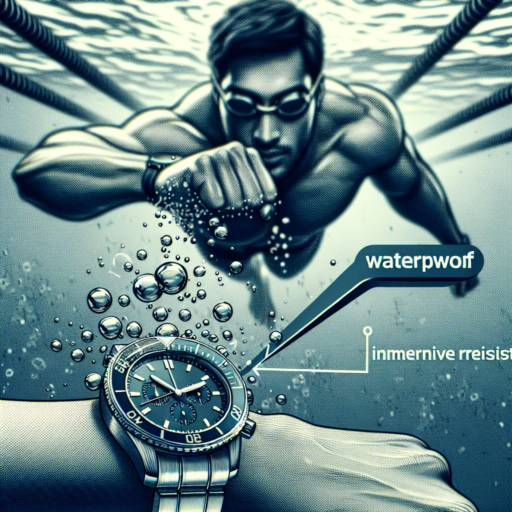Introduction to Waterproof Wristwatches: Defining the Basics
Waterproof wristwatches represent a blend of innovation and practicality, serving not just as timekeeping accessories but as resilient gear for various environments. In defining the basics of waterproof wristwatches, it’s essential to understand what makes a wristwatch waterproof, the standards that govern this quality, and why it matters to the everyday user and the adventure seeker alike. This introduction aims to shed light on these fundamental aspects, guiding potential buyers and enthusiasts through the critical information necessary for making an informed decision.
The term waterproof often suggests that a wristwatch can withstand exposure to water without succumbing to damage. However, it is crucial to distinguish between ‘water-resistant’ and genuinely ‘waterproof’ timepieces. Manufacturers test and rate their watches according to specific depths and conditions, outlined by the International Organization for Standardization, specifically in ISO 22810. This rating, often expressed in meters (m), bars (bar), or atmospheres (ATM), indicates the level of water pressure a watch can theoretically handle.
Understanding the practical applications of waterproof ratings is pivotal for selecting a watch that aligns with your needs. Whether you’re a diver needing a wristwatch that can survive the depths of the sea or simply seeking a timepiece that won’t falter in the rain, familiarity with these ratings can guide your selection. For instance, a watch rated at 30m might only be suitable for light splashes, whereas a rating of 200m or more signifies a piece designed for professional diving activities.
How to Determine if a Wristwatch is Truly Waterproof
Understanding whether your wristwatch can truly withstand water is crucial for ensuring its longevity and maintaining its functionality. One of the initial steps to take is examining the watch’s specifications. Manufacturers usually provide water resistance ratings, often indicated in meters (m), atmospheres (ATM), or bars. However, these numbers don’t directly translate to the depth you can dive with your watch. For instance, a 30m rating doesn’t mean you can take the watch 30 meters underwater. Instead, it suggests that the watch can withstand pressures equivalent to a 30m static test. Therefore, it is advisable always to refer to these specifications with a grain of caution.
Checking the Seals and Gaskets
The integrity of the seals and gaskets is paramount in determining the waterproof nature of a watch. Over time, these components can wear out or degrade, reducing the watch’s ability to keep water at bay. It’s wise to have these checked periodically by a professional, especially if you frequently expose your watch to water. Schedule a regular examination to ensure the seals and gaskets are in top condition. This preventative maintenance can save you from unexpected water damage.
Water Resistance Indicators
Some modern watches come with indicators that provide a visual signal of the watch’s water resistance integrity. These features are particularly useful for people who are into water sports or have professions that frequently involve water exposure. Despite this, not all watches come equipped with such indicators, and one should not solely rely on them for assessing a watch’s water resistance. Combining the use of these indicators with regular professional checks can offer a more comprehensive understanding of your watch’s ability to withstand water.
Top 10 Waterproof Wristwatches for Everyday Use
Finding the perfect waterproof wristwatch for everyday use is essential for anyone leading an active lifestyle or simply looking for a durable and resilient timepiece. The ideal watch not only needs to stand up to the elements but also blend seamlessly with daily outfits, providing both functionality and style. In this guide, we’ve curated a list of the top 10 waterproof wristwatches that are perfect for everyday wear, ensuring that you never have to compromise on reliability or aesthetics again.
Waterproof wristwatches have come a long way, offering varying degrees of resistance to water. Whether you’re a swimmer, a diver, or someone who occasionally gets caught in the rain, understanding the different levels of waterproofing is crucial. From watches that can withstand pressure equivalent to a depth of 30 meters, perfect for swimming and everyday use, to those rated for 200 meters, suitable for diving, the range and options available are vast. This selection aims to cater to a wide array of needs, ensuring you find a watch that fits your lifestyle perfectly.
Beyond their waterproof capabilities, these wristwatches also excel in design and functionality. Modern waterproof watches no longer look bulky or purely utilitarian; instead, they offer sleek, elegant designs that can be worn in a variety of settings, from casual day-to-day activities to more formal events. Features such as scratch-resistant faces, luminous hands for readability in low light, and robust materials like stainless steel or durable synthetics make these watches not only practical for everyday use but also fashionable accessories.
The Technology Behind Waterproof Wristwatches
Understanding the technology behind waterproof wristwatches reveals a fascinating journey of innovation and precision engineering. At the core of these devices is the principle of water resistance, which is significantly different from being entirely waterproof. This capability is measured in atmospheres (ATM), indicating the level of pressure a watch can withstand before water breaches its defenses.
Sealing Techniques and Materials
One critical component in the technology of waterproof wristwatches is the use of advanced sealing materials and methods. Manufacturers employ gaskets or O-rings made from rubber, nylon, or Teflon at strategic points, such as the case back, crown, and where the crystal meets the watch case. These materials are chosen for their resilience and ability to form a tight seal, preventing water from entering the watch’s internal mechanism.
Case and Crown Design Innovations
Another pivotal aspect is the design of the watch case and crown. The case must be robust enough to withstand the external pressure without deforming. Stainless steel, ceramics, and titanium are commonly used for their strength and corrosion resistance. The crown, which adjusts the time and date, is often a weak point for water entry. To combat this, watch manufacturers have developed screw-down crowns that, when tightened, form an impenetrable seal against water ingress.
The ingenuity involved in crafting waterproof wristwatches demonstrates a profound understanding of materials science and mechanical engineering. By integrating superior sealing technologies with innovative design elements, these timepieces not only keep accurate time but also offer unmatched durability against water pressure.
Waterproof vs. Water-Resistant Wristwatches: Understanding the Difference
When selecting the perfect wristwatch for everyday wear or specific activities, understanding the distinction between waterproof and water-resistant wristwatches is crucial. These terms often appear interchangeably in marketing materials and product descriptions, leading to confusion. However, they entail significantly different levels of protection against water.
Initially, a water-resistant wristwatch implies that it can withstand water to a certain degree but not entirely. These watches come with ratings, expressed in meters, indicating the level of pressure they can endure before water breaches the seals. For example, a watch marked as «Water Resistant to 50 meters» is suitable for swimming but may not be ideal for diving or high-impact water sports.
In contrast, waterproof wristwatches suggest an impermeability to water, offering superior protection. However, it’s essential to note that no wristwatch can be entirely waterproof, a term more accurately replaced in the industry with «water-resistant to a higher degree.» Advanced models are designed to withstand water ingress even at considerable depths, making them the preferred choice for professional divers and aquatic athletes.
How to Care for and Maintain Your Waterproof Wristwatch
Caring for and maintaining your waterproof wristwatch is essential to ensure its longevity and optimal performance. Waterproof watches are engineered to withstand water pressure up to a certain depth, making them perfect companions for swimmers, divers, and anyone who comes into regular contact with water. However, to keep these timepieces in prime condition, a few careful practices should be observed.
Routine Cleaning
To start, routine cleaning is paramount. After any exposure to saltwater or chlorine, gently rinse your watch under lukewarm, fresh water. Use a soft, damp cloth to clean the case and strap meticulously. For metal straps, a soft-bristled toothbrush can help remove any debris lodged in the bracelet links. Remember, accumulation of salts and chemicals can degrade water-resistant seals and the aesthetic look of your watch over time.
Regular Service Checks
Another critical aspect is ensuring your watch undergoes regular service checks. Manufacturers typically recommend a professional inspection every 1 to 2 years. During these checks, a specialist will assess the condition of the seals and test water resistance. A worn seal can compromise the watch’s waterproof integrity, making these inspections crucial for prevention. Additionally, this is an opportunity to have the movement checked and lubricated, ensuring the mechanics continue to operate smoothly.
By adhering to these maintenance routines, you not only preserve the water resistance of your timepiece but also its visual appeal and mechanical integrity. Whether it’s after a swim in the ocean or a day of casual wear, a little care can go a long way in extending the lifespan of your waterproof wristwatch.
Waterproof Wristwatches for Divers: What to Look For
When embarking on a quest to find the perfect waterproof wristwatch that meets the unique demands of underwater exploration, there are several key features that divers should prioritize. Ensuring your wristwatch can withstand the extreme conditions of diving not only elevates your underwater experience but also ensures the durability and longevity of the watch. Below are vital components to consider when selecting a waterproof wristwatch for diving.
Water Resistance Depth
Depth rating is a pivotal aspect of any diver’s watch. Look for watches that offer a water resistance of at least 200 meters (660 feet) to ensure it can handle deep dives. However, for more serious scuba divers or professional use, wristwatches with a rating of 300 meters (1000 feet) or more are recommended. This depth resistance ensures that the watch can withstand the pressure at the depths to which you dive.
Durability and Construction
The build quality of your waterproof wristwatch is crucial for withstanding the harsh conditions underwater. Opt for watches made with high-grade materials like stainless steel, titanium, or ceramics. These materials not only offer superior durability but also resistance to corrosion caused by saltwater. Additionally, ensure that the wristwatch comes with a scratch-resistant sapphire crystal face, as it will maintain visibility and withstand the inevitable bumps and scrapes encountered during dives.
Visibility and Illumination
Being able to read your wristwatch in the low-light conditions of the underwater world is non-negotiable. High-quality divers’ watches feature luminous hands and markers that glow in the dark, ensuring you can always monitor your time and dive duration accurately. Moreover, consider wristwatches with large, clear dials and anti-reflective coatings for ease of reading under any conditions.
The Evolution of Waterproof Wristwatches: From the Past to Present
The journey of waterproof wristwatches is a fascinating tale of innovation, endurance, and the relentless pursuit of precision. Initially, wristwatches faced significant challenges against water exposure, which led to rapid deterioration and inaccurate timekeeping. Over time, the advent of new technologies transformed these delicate timepieces into robust symbols of resilience capable of withstanding the pressures of the deep sea.
Early Attempts at Waterproofing
Early attempts at waterproofing wristwatches involved rudimentary solutions such as protective leather covers and tight gaskets. However, these were not enough to prevent moisture ingress. It was not until the 1920s that significant advancements were made. Swiss watchmakers introduced the first genuinely waterproof wristwatch cases, featuring revolutionary sealing techniques that included screw-down crowns and back cases, significantly enhancing water resistance.
No se han encontrado productos.
Breakthrough Technologies and Innovations
The mid-20th century marked the dawn of transformative breakthroughs in waterproof wristwatch design. The introduction of synthetic rubber gaskets and improved sealing methodologies allowed wristwatches to achieve unparalleled depths. Companies competed to conquer the depths of the ocean, with each innovation setting new benchmarks for water resistance. Diving watches became symbols of adventure, equipped with rotating bezels to track underwater time and helium escape valves for deep-sea exploration.
Must-Have Waterproof Wristwatch Features for Outdoor Enthusiasts
When looking for the perfect wristwatch for outdoor adventures, waterproof capabilities are just the beginning. Outdoor enthusiasts need a watch that integrates several critical features to ensure durability, reliability, and functionality amidst challenging weather conditions and varied outdoor activities. Highlighting the most sought-after attributes can guide you in selecting a wristwatch that won’t let you down when you venture into the wild.
Advanced Water Resistance
A crucial feature for any outdoor-centric wristwatch is its level of water resistance. While many watches are marketed as waterproof, it’s essential to understand the difference in water resistance levels and what they mean for your outdoor activities. Look for a watch that offers at least a 100-meter water resistance rating to ensure it can withstand not just rain or splashes but also suitable for swimming, snorkeling, and possibly even shallow diving.
Rugged Construction
Durability is another key factor, as outdoor watches are exposed to harsh conditions, including heavy impacts, scratches, and extreme temperatures. A wristwatch constructed with a high-strength, scratch-resistant material such as sapphire crystal for the dial window, and a case and band made from tough materials like stainless steel or high-grade silicone or rubber, ensures your timepiece can handle the rigors of outdoor activities without fail.
Additional Outdoor-centric Features
Beyond water resistance and durability, certain functionalities make a wristwatch more suited for outdoor adventures. These include a built-in compass for navigation, a barometer for weather forecasting, an altimeter for altitude measurement, and a thermometer. A long-lasting battery life or solar charging capability can also be incredibly beneficial, ensuring your watch remains operational through your expeditions. GPS functionality is a plus for those who require precise location tracking during their outdoor pursuits.
Frequently Asked Questions About Waterproof Wristwatches
Certainly, focusing on the theme of frequently asked questions about waterproof wristwatches, it’s essential to address various aspects that consumers commonly query. Within this scope, three key questions often arise, reflecting durability, usability, and care instructions for these sophisticated timepieces. Let’s delve into these aspects:
How Waterproof is a Waterproof Wristwatch Really?
The term «waterproof» can sometimes be misleading as no wristwatch can be entirely impervious to water under all conditions. Waterproof wristwatches are generally rated by their resistance depth, measured in meters (m) or atmospheres (ATM). A 30m/3ATM rating signifies that the watch can withstand splashes or brief immersion in water, whereas a 200m/20ATM rating indicates suitability for diving. It’s vital to consult your wristwatch’s specific rating to understand the extent of its water resistance.
Can I Go Swimming with My Waterproof Wristwatch?
Swimming with a waterproof wristwatch is possible, but it depends on the watch’s water resistance level. For light swimming, a watch with a minimum rating of 50m/5ATM is often satisfactory. However, for more vigorous water activities such as diving or snorkeling, a watch with a higher rating of at least 100m/10ATM is advisable. Always ensure your watch’s seals and gaskets are intact before exposing it to significant water activity.
How Do I Care for My Waterproof Wristwatch?
Caring for your waterproof wristwatch extends its lifespan and maintains its functionality. After exposure to saltwater, rinse the watch with fresh water and dry it with a soft cloth. For daily wear, cleaning the watch with a damp cloth to remove sweat and dirt is recommended. Also, have the water resistance of your watch checked annually by a professional, especially if you frequently engage in water-related activities. This preventative measure helps in maintaining the watch’s waterproof integrity over time.




